Must-Visit Cultural Sites
Hey there, culture lovers!
If you’re exploring Korea, you won’t want to miss these must-visit cultural sites that showcase the country’s rich history and vibrant traditions.
Here’s a friendly guide to some of the most famous spots, complete with links for more information!
Royal Palaces
– Gyeongbokgung Palace –

- Why Visit:
Gyeongbokgung Palace is the largest and most iconic palace of the Joseon Dynasty, offering a glimpse into Korea’s royal history and traditional architecture. It’s a must-visit for its cultural significance and stunning surroundings. - Must-Try:
- Walk through the Gwanghwamun Gate, the palace’s grand entrance.
- Visit Gyeonghoeru Pavilion and Hyangwonjeong Pavilion for picturesque views.
- Explore the National Palace Museum and National Folk Museum within the complex.
- Description:
Built in 1395 by King Taejo, Gyeongbokgung was the main royal palace of the Joseon Dynasty. Despite destruction during wars and Japanese occupation, it has been extensively restored since the 1990s, showcasing traditional Korean architecture and heritage. - Highlights:
- Stunning pavilions like Gyeonghoeru, set against Mount Bugaksan.
- Historical structures such as Geunjeongjeon Hall, used for royal ceremonies.
- Nighttime illuminations that highlight its architectural beauty.
- Tip:
Visit in the morning to avoid crowds or during the evening for illuminated views. Don’t miss the changing of the guard ceremony at Gwanghwamun Gate!
– Changdeokgung Palace –
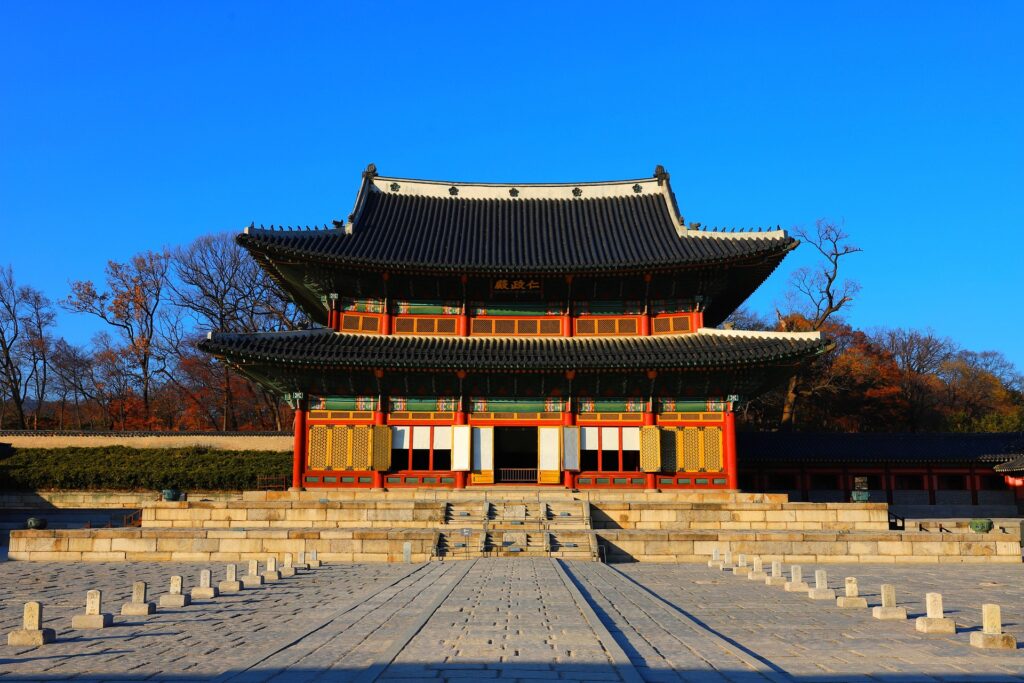
- hy Visit:
Changdeokgung Palace is a UNESCO World Heritage Site and one of the most beautiful examples of Korean palace architecture, harmoniously blending with its natural surroundings. It offers a glimpse into the history and culture of the Joseon Dynasty. - Must-Try:
- Explore the Secret Garden (Huwon), a serene royal retreat.
- Visit Injeongjeon Hall, the main throne hall.
- Enjoy seasonal beauty, especially during autumn foliage or cherry blossoms.
- Description:
Built in 1405, Changdeokgung served as the primary residence for many Joseon kings. Unlike other palaces, its layout follows the natural topography, reflecting pungsu (Korean feng shui) principles. The palace includes administrative buildings, royal quarters, and the famous Secret Garden.Highlights:- Stunning architecture blending with nature.
- Historical significance as Korea’s de facto main palace for 270 years.
- Cultural treasures like Daejojeon Hall and Buyongjeong Pavilion.
- Tip:
Book a guided tour to access the Secret Garden and visit early to avoid crowds. Autumn is the best season for spectacular views!
Buddhist Treasures
– Bulguksa Temple –
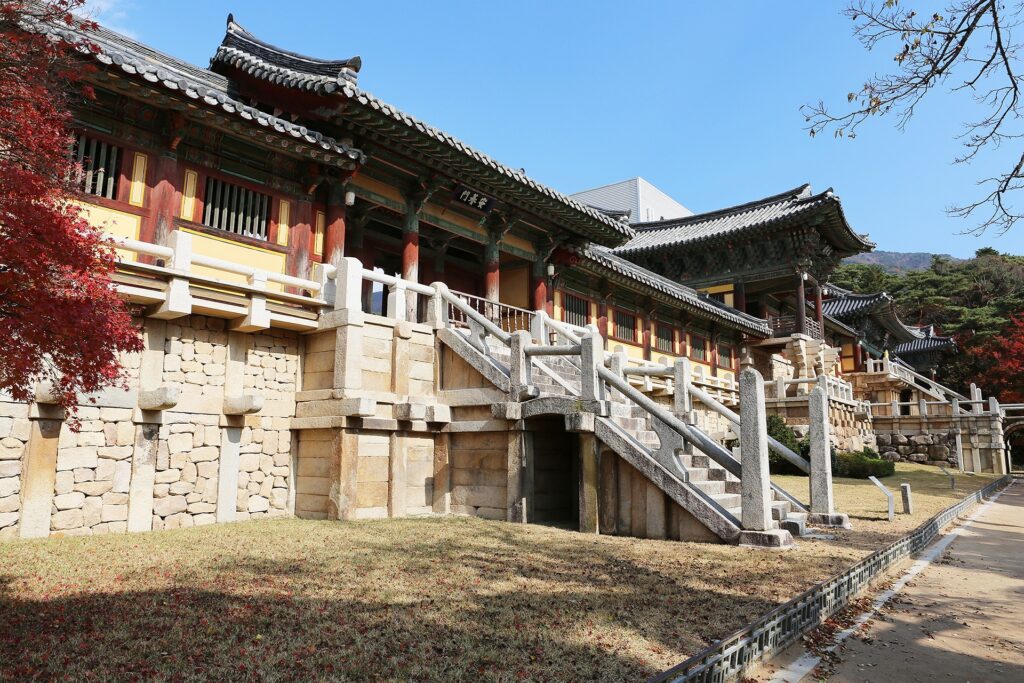
- Why Visit:
Bulguksa Temple is a UNESCO World Heritage Site and a masterpiece of Buddhist art and architecture from the Silla Dynasty. It’s a must-visit for its serene atmosphere, historical significance, and stunning craftsmanship. - Must-Try:
- Admire the Dabotap and Seokgatap stone pagodas.
- Explore the stone bridges and terraces symbolizing Buddha’s land.
- Visit nearby Seokguram Grotto, part of the same heritage complex.
- Description:
Built in 774, this temple on Mount Tohamsan represents the spiritual realm of Buddha on Earth. It features intricate stonework, wooden halls, and relics of Buddhist culture, making it a treasure of Korean history. - Highlights:
- Two National Treasure pagodas: Dabotap and Seokgatap.
- Stunning views of Mount Tohamsan.
- A blend of nature and architecture symbolizing enlightenment.
- Tip:
Visit early to enjoy the peaceful surroundings and take time to explore both Bulguksa Temple and Seokguram Grotto for a complete experience!
– Seokguram Grotto –
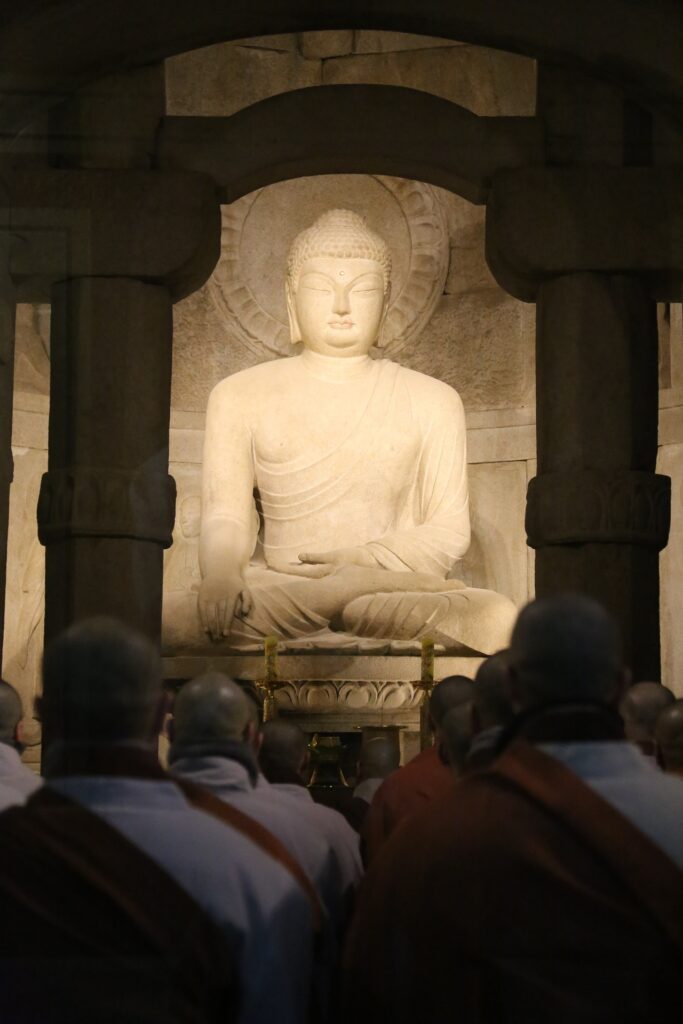
- Why Visit:
Seokguram Grotto is a UNESCO World Heritage Site and one of South Korea’s most treasured cultural landmarks. It offers a serene blend of natural beauty and exquisite Buddhist art, with a breathtaking view of the East Sea. - Must-Try:
- Marvel at the Sakyamuni Buddha statue, surrounded by intricately carved Bodhisattvas and guardians.
- Enjoy the sunrise view over the East Sea from the grotto.
- Explore the nearby Bulguksa Temple, part of the same heritage complex.
- Description:
Constructed in the 8th century during the Silla Dynasty, Seokguram is an artificial granite cave housing a monumental Buddha statue. It exemplifies advanced architectural and artistic techniques of its time, symbolizing spiritual enlightenment. - Highlights:
- Stunning Buddhist sculptures in high and low relief.
- Innovative dome structure made of over 360 stone slabs.
- Its historical significance as part of Korea’s oldest UNESCO site (since 1995).
- Tip:
Visit early in the morning for fewer crowds and to catch the sunrise. Wear comfortable shoes for the hike up Mount Tohamsan!
Historic Districts
– DMZ –

- Why Visit:
The Korean Demilitarized Zone (DMZ) is a historic and symbolic area dividing North and South Korea. It offers a unique insight into the Korean War, ongoing tensions, and hopes for peace, making it one of the most intriguing destinations in the world. - Must Try:
- Third Infiltration Tunnel: Walk through a secret tunnel built by North Korea for potential invasion.
- Dora Observatory: Peer into North Korea using telescopes to view the propaganda village of Kijong-dong.
- Imjingak Resort: Explore monuments, museums, and the Freedom Bridge.
- Joint Security Area (JSA): Stand on the border between North and South Korea at Panmunjom (currently suspended).
- Highlights:
- 250 km long, 4 km wide buffer zone established in 1953.
- Key sites include observation decks, historical landmarks, and peace-themed attractions.
- Guided tours provide in-depth stories and safe access to restricted areas.
- Tip:
Book a guided tour at least 24 hours in advance (passport required). Visit in spring or fall for the best weather, and follow your guide’s instructions carefully in this active military zone.
– Jeonju Hanok Village –
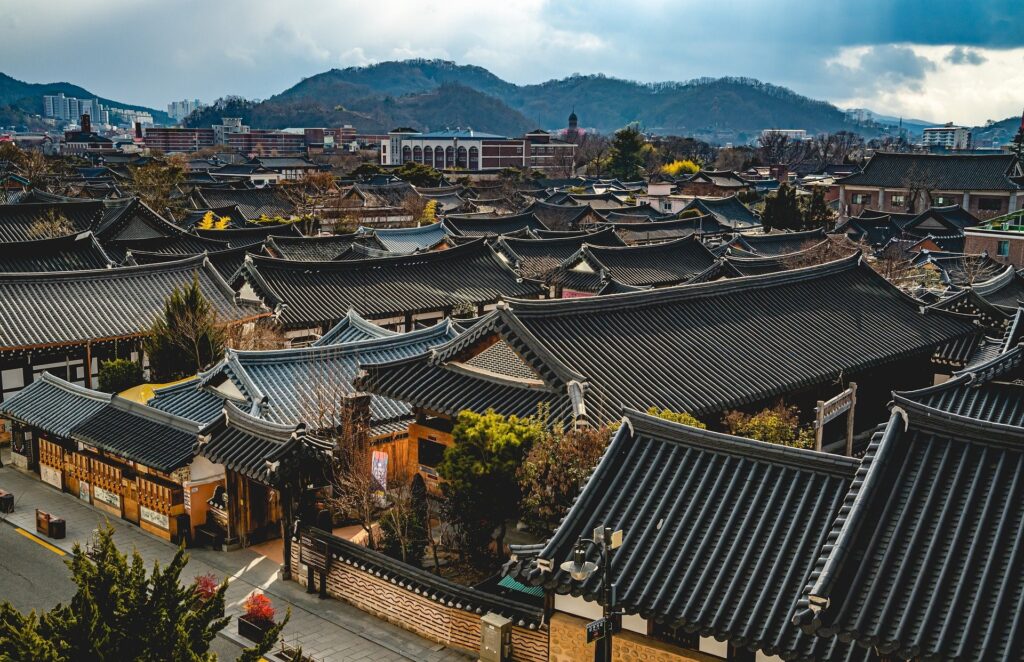
- Why Visit:
Jeonju Hanok Village is South Korea’s largest traditional Hanok village, featuring over 700 beautifully preserved Korean houses. It offers a unique opportunity to experience Korea’s traditional culture, architecture, and food amidst a serene yet vibrant atmosphere. - Must-Try:
- Stroll through the picturesque Hanok streets.
- Rent a hanbok (traditional Korean attire) for photos.
- Try Jeonju’s famous bibimbap and street food.
- Visit the Gyeonggijeon Shrine and Royal Portrait Museum.
- Description:
Located in Jeonju, this historic village blends tradition and modernity, with charming Hanok homes serving as cafes, museums, and accommodations. The area is recognized as a “Slow City,” emphasizing relaxation and cultural immersion. - Highlights:
- Stunning views of tiled rooftops from Omokdae Pavilion.
- Unique experiences like Hanok stays and tea ceremonies.
- Seasonal charm with festivals and changing landscapes.
- Tip:
Visit early to avoid crowds, and don’t miss nearby attractions like Jaman Mural Village for colorful photo spots!
Modern Culture
– N Seoul Tower-
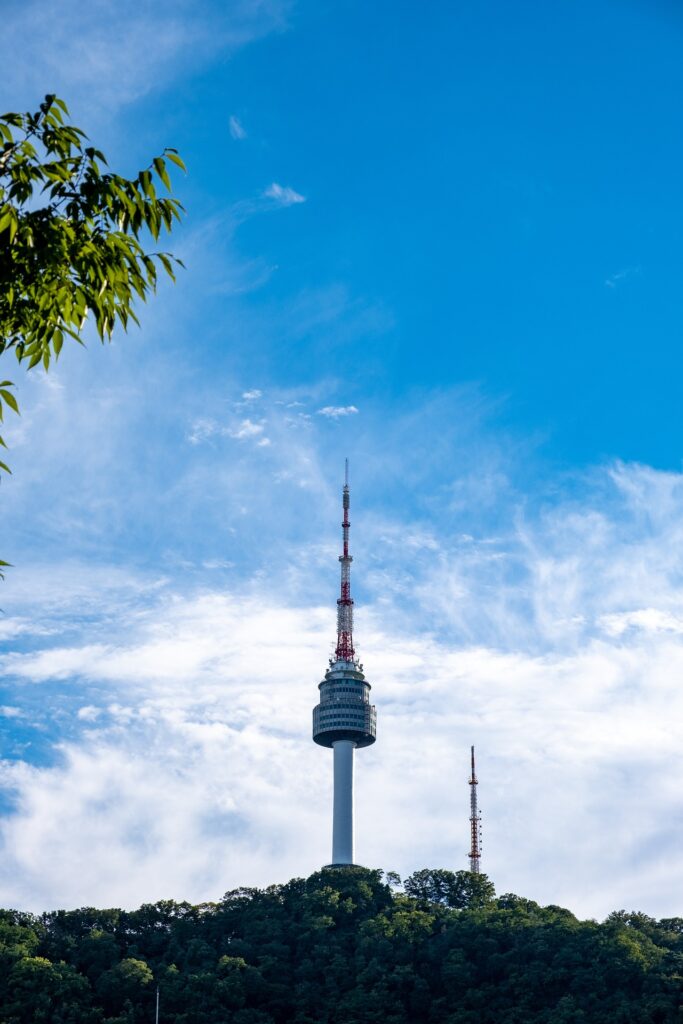
- Why Visit:
N Seoul Tower is an iconic landmark and the second-highest point in Seoul, offering stunning 360-degree views of the city from atop Namsan Mountain. It’s a must-visit for its breathtaking scenery, cultural significance, and romantic atmosphere. - Must-Try:
- Observatory Decks: Enjoy panoramic city views.
- Locks of Love: Attach a love lock on the terrace.
- N Grill: Dine at the revolving French restaurant.
- Namsan Cable Car: Ride to the base of the tower for scenic views.
- Description:
Built in 1969 as South Korea’s first general radio wave tower, N Seoul Tower combines communication technology with tourism. It features observation decks, restaurants, and cultural exhibits, blending modern design with natural surroundings. - Highlights:
- Stunning night illumination with LED displays.
- Romantic spots like the Love Lock Terrace.
- Historical significance as Korea’s first multipurpose tower.
- Tip:
Visit at sunset for the best views and avoid weekends to skip crowds. Use the cable car or shuttle bus for easy access to the tower!
– National Museum of Korea –
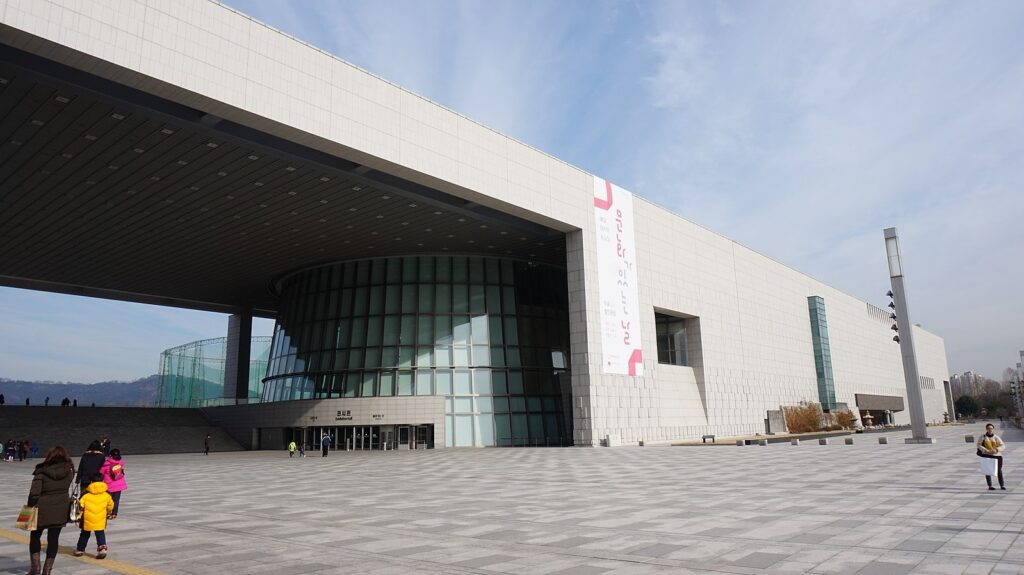
- Why Visit:
The National Museum of Korea is the largest and most comprehensive museum in South Korea, showcasing over 410,000 artifacts spanning 5,000 years of Korean history and culture. It’s a perfect destination to immerse yourself in Korea’s rich heritage. - Must-Try:
- Explore Pensive Bodhisattva and other national treasures.
- Visit the Seoul Sinan Undersea Relics for a glimpse into maritime Silk Road trade.
- Stroll through the Asian Art Gallery for international masterpieces.
- Description:
Established in 1945 and relocated to Yongsan in 2005, the museum features six permanent galleries, including Prehistory, Calligraphy, and Sculpture. It also offers cultural programs, a children’s museum, and scenic outdoor spaces like the Reflecting Pond.Highlights:- National Treasures: Goryeo Celadon, Silla Gold Crown, and Ten-Story Pagoda.
- The Joseon Dynasty Gallery, showcasing Korea’s artistic peak.
- Interactive exhibits and English-language tours.
- Tip:
Arrive early to join a guided tour at 11 AM or 2 PM. Don’t miss the outdoor park for a relaxing break after exploring the galleries!
– Lotte Tower –
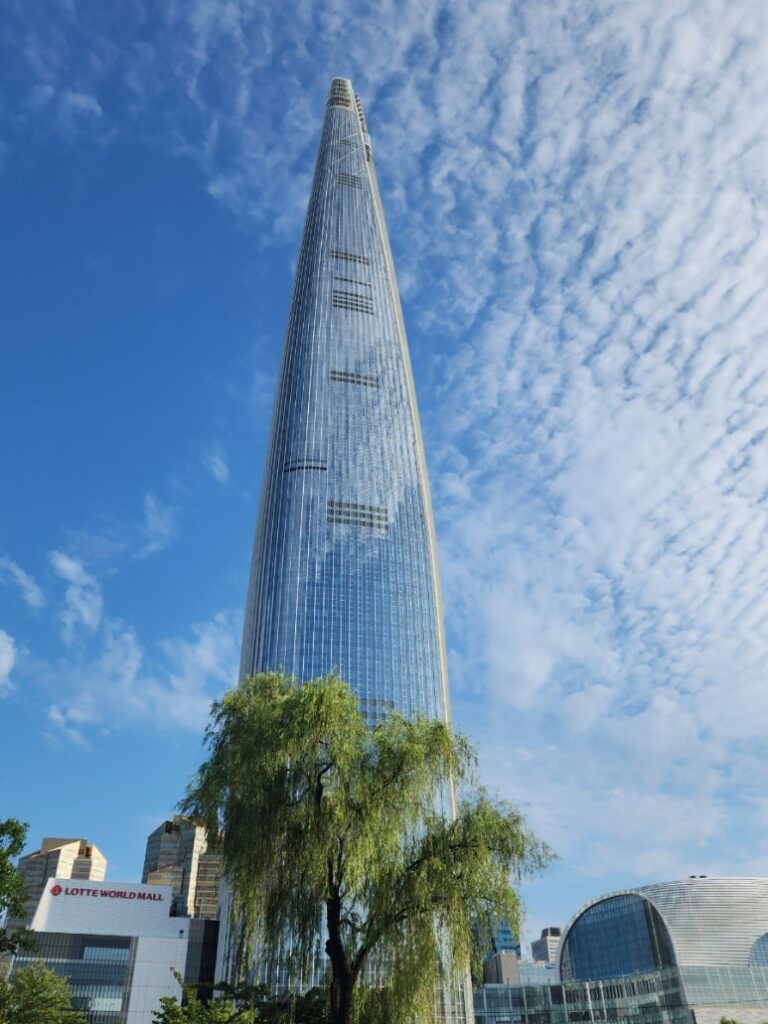
- Why Visit:
Lotte World Tower is South Korea’s tallest building and the 5th tallest in the world, offering stunning views of Seoul and a mix of modern architecture and culture. - Must-Try:
- Seoul Sky Observatory for panoramic views.
- The Sky Deck with a glass floor.
- The Sky Shuttle, a high-speed elevator.
- Shopping and entertainment at Lotte World Mall.
- Description:
A 555-meter, 123-floor skyscraper blending Korean tradition and innovation, featuring luxury hotels, offices, shopping, and cultural attractions. - Highlights:
- Breathtaking views from Seoul Sky.
- Sleek Korean-inspired design.
- Stunning nighttime illumination.
- Tip:
Visit at sunset for the best views, and book tickets online to skip lines!
※ Remember
These cultural sites offer a glimpse into Korea’s fascinating past and vibrant present.
So grab your camera, immerse yourself in the culture, and enjoy your journey through the Land of Morning Calm!
© 2025 All Rights Reserved.
